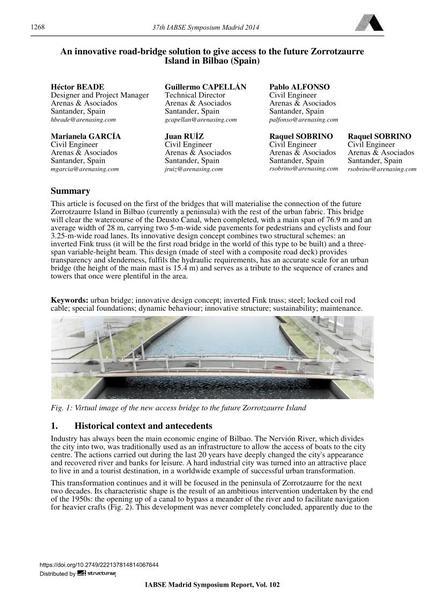An innovative road-bridge solution to give access to the future Zorrotzaurre Island in Bilbao (Spain)

|
|
|||||||||||
Bibliographic Details
| Author(s): |
Hector Beade
Guillermo Capellán Pablo Alfonso Marianela García Juan Ruiz Raquel Sobrino |
||||
|---|---|---|---|---|---|
| Medium: | conference paper | ||||
| Language(s): | English | ||||
| Conference: | IABSE Symposium: Engineering for Progress, Nature and People, Madrid, Spain, 3-5 September 2014 | ||||
| Published in: | IABSE Symposium Madrid 2014 | ||||
|
|||||
| Page(s): | 1268-1275 | ||||
| Total no. of pages: | 8 | ||||
| Year: | 2014 | ||||
| DOI: | 10.2749/222137814814067644 | ||||
| Abstract: |
This article is focused on the first of the bridges that will materialise the connection of the future Zorrotzaurre Island in Bilbao (currently a peninsula) with the rest of the urban fabric. This bridge will clear the watercourse of the Deusto Canal, when completed, with a main span of 76.9 m and an average width of 28 m, carrying two 5-m-wide side pavements for pedestrians and cyclists and four 3.25-m-wide road lanes. Its innovative design concept combines two structural schemes: an inverted Fink truss (it will be the first road bridge in the world of this type to be built) and a three- span variable-height beam. This design (made of steel with a composite road deck) provides transparency and slenderness, fulfils the hydraulic requirements, has an accurate scale for an urban bridge (the height of the main mast is 15.4 m) and serves as a tribute to the sequence of cranes and towers that once were plentiful in the area. |
||||
| Keywords: |
steel sustainability dynamic behavior maintenance special foundations urban bridge innovative structure inverted fink truss innovative design concept locked coil rod cable
|
||||
